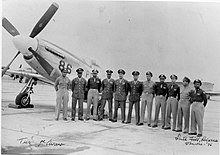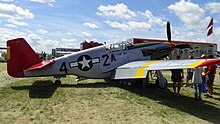‘Top Gun’ as a pop culture term is commonly associated with the U.S. Navy’s Fighter Weapons School (established in 1969), but before that, the U.S. Air Force held its own air combat competitions. The 1949 U.S. Air Force Fighter Weapons Meet was exactly that—an elite aerial gunnery competition to determine the best fighter pilots.
Whether you call it ‘Top Gun’ or not doesn’t change the fact that the Tuskegee Airmen won and were denied proper recognition. Moving the goalposts won’t erase history
I'm not moving the goal posts, I'm defining them better than you have !
Not that with all your bluster you fail to provide and references or links to substantiate your claims or the real truths.
FWIW, many of us, especially in the aviation community, have know of the Red Tails almost from their beginning.
Here's one easy to find reference;
...
Postwar

Various Tuskegee Airmen by a P-51 Mustang at
Luke Field, around January or February 1946.
Contrary to negative predictions from some quarters, Tuskegee Airmen were some of the best pilots in the U.S. Army Air Forces due to a combination of pre-war experience and the personal drive of those accepted for training. Nevertheless, the Tuskegee Airmen continued to have to fight
racism. Their combat record did much to quiet those directly involved with the group, but other units continued to harass these airmen.
[97]
In 1949, the 332nd entered the annual U.S. Continental Gunnery Meet in Las Vegas, Nevada. The competition included shooting aerial and ground targets and dropping bombs on targets. Flying the long-range Republic P-47N Thunderbolt (built for the long-range escort mission in the
Pacific theatre of World War II), the 332nd Fighter Wing took first place in the conventional fighter class. The pilots were Captain
Alva Temple, Lts.
Harry Stewart, Jr.,
James H. Harvey III and
Halbert Alexander. Staff Sergeant
Buford A. Johnson (30 August 1927 – 15 April 2017) served as the pilots' aircraft crew chief.
[98] Lt. Harvey said, "We had a perfect score. Three missions, two bombs per plane. We didn't guess at anything, we were good."
[99] They received congratulations from the governor of Ohio and Air Force commanders across the nation.
[100]
After segregation in the military was ended in 1948 by President
Harry S. Truman with
Executive Order 9981, the veteran Tuskegee Airmen found themselves in high demand throughout the newly formed
United States Air Force. Some taught in civilian flight schools, such as the black-owned
Columbia Air Center in Maryland.
[101] On 11 May 1949,
Air Force Letter 35.3 mandated that black Airmen be screened for reassignment to formerly all-white units according to qualifications.
[102]
Tuskegee Airmen were instrumental in postwar developments in aviation. Edward A. Gibbs, a civilian flight instructor who helped launch in the U.S. Aviation Cadet Program at Tuskegee,
[103] later became the founder of
Negro Airmen International, an association joined by many airmen. USAF General
Daniel "Chappie" James Jr. (then Lt.) was an instructor of the 99th Pursuit Squadron and later a fighter pilot in Europe. In 1975, he became the first African-American to reach the rank of
four-star general.
[104] Post-war commander of the 99th Squadron
Marion Rodgers went on to work in communications for
NORAD and as a program developer for the
Apollo 13 project.
[105]
...

en.wikipedia.org






